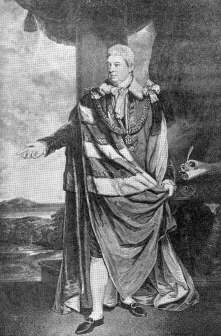

John Murray, b.30 June 1755, d.1830, eldest son of John, 3rd Duke of Atholl, who had been the last Atholl Lord of Man before selling the regalities at the Revestment.
Twice married - first (26 Dec 1774) to Jane, eldest daughter of Charles 9th Lord Calcart, by whom he had nine children. She died 4 Sept 1790. He married secondly (11 March 1794) Margery by whom he had two children. She was eldest daughter of James 16th Lord Forbes and relict (they had married in 1786) of John McKenzie, Lord Macleod (eldest son of George 3rd Earl of Cromartie who had forfeited his title by joining rebellion of 1745); she died 4 Oct 1842.
He believed his parents had been induced to sell the regalities much too cheaply and forced the British Government to hold a number of inquiries. The Island authorities strenuously opposed his attempts which in 1792 led to the visit of 5 commissioners who produced a very valuable report on the then economic state of the Island. The report backed the Duke's contention that the original purchase price was too low but pointed out that most of the revenues were due to smuggling activities. As a sop to the Duke the British Government offered him the post of Captain-General and Governor. Initially he was welcomed, possibly in the belief that he would rest satisfied and not push his claims any further. However he continued to push his claims and quickly lost any popularity with the native Manx. as Train (a fellow Scot writing in the 1830's) puts it " the maintenance of his private rights, by the exercise of his power as governor, in appointing to all the different departments, to which either his patronage or influence could extend, persons connected with or depending on his family, generally to the exclusion of the natives, furnished a theme of jealousy and indignation for the islanders at large" or as the Manx had it "Murrays, Murrays everywhere".
There quickly arose a divide between most of the Manx, led, it must be admitted, by a self-elected and increasingly conservative House of Keys, who opposed the 'grasping Murrays' and the non-Manx immigrants who appreciated the Duke's attempt to modernise the Island. In 1808 the British Government appointed Col. Smelt as Lieutenant Governor who managed to retain the trust of the Manx though generally despised by the Duke's party.
Major interests were in Scotland where he was lord-lieutenant of Perthshire from 1794 to his death in 1830. had a major interest in afforestation and was reported to be the first to have planted larch on a large scale in Scotland; on which subject he wrote 'Observations on Larch' published London.
John Murray built himself a 'palace' in Castle Mona and attempted to develop the tourist trade to the Island. However it was the appointment of his young nephew as Bishop in 1814 and the latter's insensitive attempt to extract £6,000 pa from the tithes at the period when agriculture was depressed that finally provoked riots and the departure of both Bishop and Duke. Train's summary of him as "His grace was an active, liberal, and enlightened nobleman: he possessed considerable interest at court, which he uniformly employed in advancing the real interests of his Island" could be equally balanced by Callow's comment 'The Athol rule ended in 1825 A.D. Te Deum Laudamus."
D. Winterbottom Governors of the Isle of Man since 1765 Douglas: Manx National Heritage 1999 (ISBN 09524019-5-9)
|
|
||
|
Any comments, errors or omissions
gratefully received The
Editor |
||